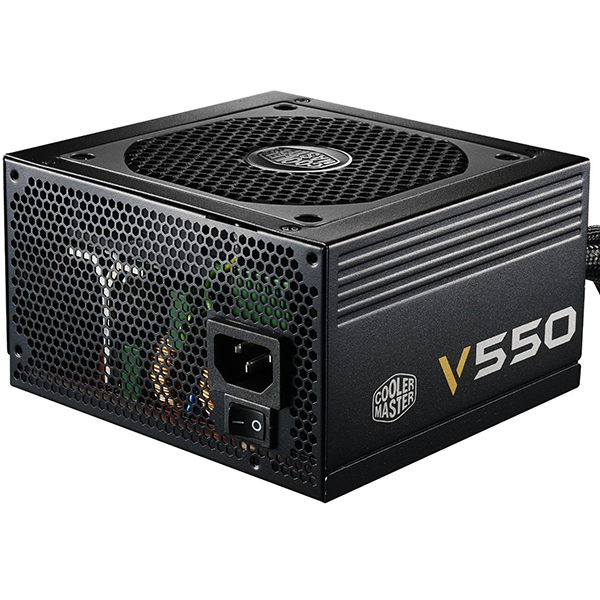be quiet! Pure Power 9 600W PSU Review
be quiet! released the updated Pure Power 9 series that consists of four semi-modular models with capacities ranging from 400W to 700W. Today, we're looking at the 600W implementation to see where it stands in the competitive mainstream market.
Why you can trust Tom's Hardware
Load Regulation, Hold-Up Time And Inrush Current
To learn more about our PSU tests and methodology, please check out How We Test Power Supply Units.
Primary Rails And 5VSB Load Regulation
Load Regulation testing is detailed here.


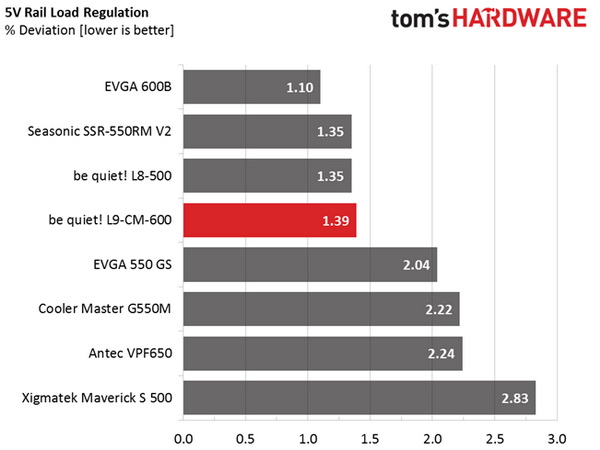

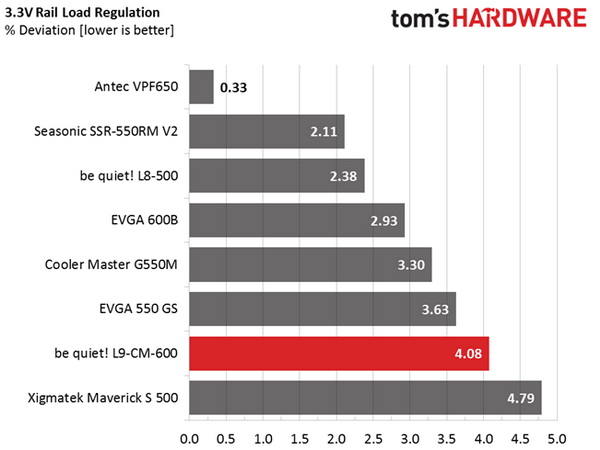

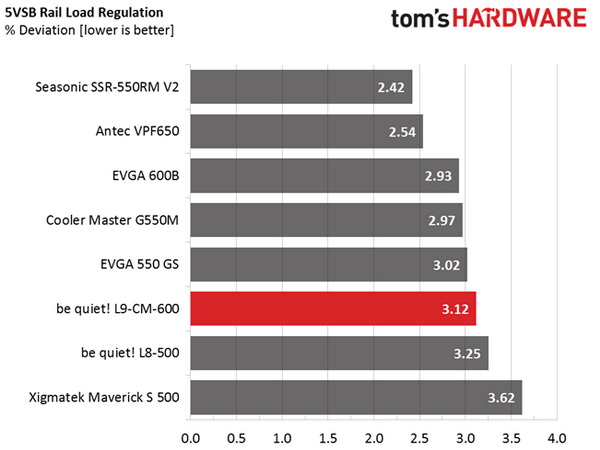

Hold-Up Time
Our hold-up time tests are described in detail here.

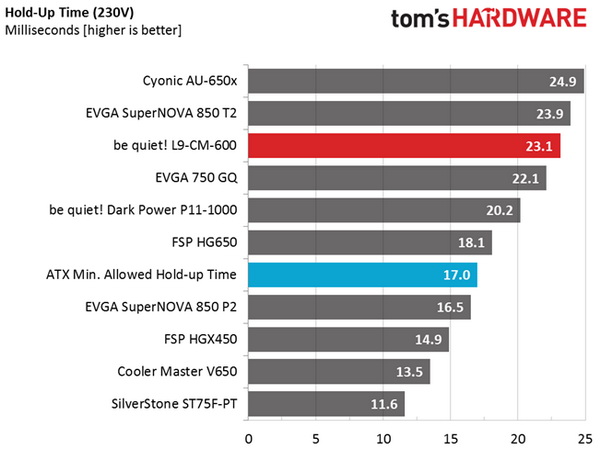

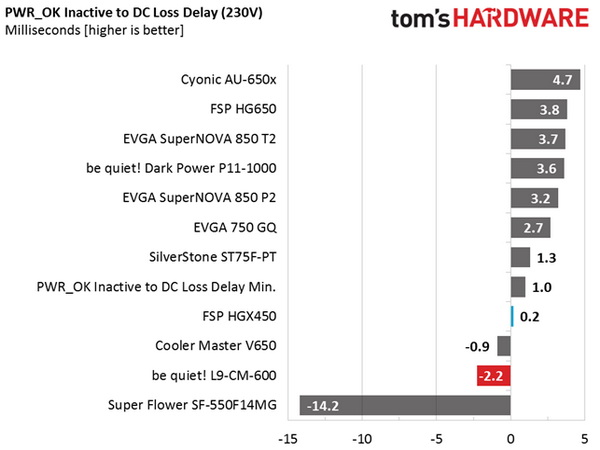


The hold-up time is much longer than the ATX spec's minimum requirement. But there's a catch. The power-good signal lasts longer, so when it drops, the voltage level of the +12V rail is already below 11V. This can lead to huge stress on the voltage regulators of the parts inside your PC. Fortunately, FSP should be able to fix the issue easily.
Inrush Current
For details on our inrush current testing, please click here.


The lack of an NTC thermistor leads to high inrush currents.
Load Regulation And Efficiency Measurements
The first set of tests reveals the stability of the voltage rails and the PSU's efficiency. The applied load equals (approximately) 10 to 110 percent of the maximum load the supply can handle, in increments of 10 percentage points.
Get Tom's Hardware's best news and in-depth reviews, straight to your inbox.
We conducted two additional tests. During the first, we stressed the two minor rails (5V and 3.3V) with a high load, while the load at +12V was only 0.10A. This test reveals whether a PSU is Haswell-ready or not. In the second test, we determined the maximum load the +12V rail could handle with minimal load on the minor rails.
| Test # | 12V | 5V | 3.3V | 5VSB | DC/AC (Watts) | Efficiency | Fan Speed (RPM) | Noise (dB[A]) | Temps (In/Out) | PF/AC Volts |
|---|---|---|---|---|---|---|---|---|---|---|
| 1 | 3.146A | 1.993A | 1.966A | 0.996A | 59.80 | 85.38% | 565 | 17.5 | 36.88 °C | 0.967 |
| 12.150V | 5.015V | 3.353V | 5.011V | 70.04 | 39.24 °C | 115.1V | ||||
| 2 | 7.340A | 2.989A | 2.960A | 1.200A | 119.78 | 89.08% | 565 | 17.5 | 38.84 °C | 0.983 |
| 12.117V | 5.005V | 3.340V | 4.996V | 134.47 | 42.04 °C | 115.1V | ||||
| 3 | 11.917A | 3.497A | 3.479A | 1.401A | 179.88 | 89.92% | 565 | 17.5 | 39.20 °C | 0.989 |
| 12.069V | 5.004V | 3.326V | 4.983V | 200.05 | 42.69 °C | 115.0V | ||||
| 4 | 16.522A | 3.993A | 3.974A | 1.608A | 239.76 | 89.90% | 565 | 17.5 | 39.64 °C | 0.994 |
| 12.021V | 5.003V | 3.316V | 4.970V | 266.70 | 43.55 °C | 115.1V | ||||
| 5 | 20.788A | 5.005A | 4.992A | 1.814A | 299.70 | 89.47% | 565 | 17.5 | 40.83 °C | 0.996 |
| 11.991V | 4.989V | 3.300V | 4.956V | 334.96 | 45.13 °C | 115.1V | ||||
| 6 | 25.084A | 6.023A | 6.019A | 2.020A | 359.70 | 88.60% | 680 | 18.7 | 42.13 °C | 0.997 |
| 11.958V | 4.980V | 3.284V | 4.941V | 405.98 | 47.10 °C | 115.1V | ||||
| 7 | 29.387A | 7.039A | 7.059A | 2.230A | 419.60 | 87.84% | 865 | 22.0 | 43.05 °C | 0.998 |
| 11.930V | 4.967V | 3.267V | 4.927V | 477.68 | 48.43 °C | 115.1V | ||||
| 8 | 33.755A | 8.067A | 8.102A | 2.439A | 479.64 | 86.83% | 1040 | 27.0 | 44.58 °C | 0.998 |
| 11.889V | 4.958V | 3.253V | 4.910V | 552.42 | 50.40 °C | 115.1V | ||||
| 9 | 38.645A | 8.566A | 8.664A | 2.444A | 539.66 | 85.60% | 1220 | 33.0 | 45.13 °C | 0.998 |
| 11.829V | 4.961V | 3.238V | 4.902V | 630.48 | 51.28 °C | 115.1V | ||||
| 10 | 43.332A | 9.071A | 9.194A | 3.071A | 599.51 | 84.18% | 1350 | 33.7 | 45.69 °C | 0.997 |
| 11.767V | 4.960V | 3.224V | 4.880V | 712.14 | 52.45 °C | 115.1V | ||||
| 11 | 48.813A | 9.041A | 9.228A | 3.077A | 659.45 | 82.42% | 1700 | 37.1 | 47.00 °C | 0.997 |
| 11.673V | 4.980V | 3.212V | 4.871V | 800.13 | 54.57 °C | 115.1V | ||||
| CL1 | 0.101A | 17.018A | 17.004A | 0.003A | 135.02 | 79.07% | 1065 | 28.5 | 44.83 °C | 0.987 |
| 12.936V | 4.595V | 3.264V | 4.993V | 170.77 | 49.93 °C | 115.1V | ||||
| CL2 | 47.966A | 1.002A | 1.003A | 1.002A | 561.18 | 84.64% | 1325 | 33.5 | 46.19 °C | 0.998 |
| 11.420V | 5.160V | 3.268V | 4.950V | 663.00 | 53.59 °C | 115.1V |
The load regulation we measured is nothing to write home about. It's loose on all rails except for 5V. On the other hand, efficiency is quite high given this unit's 80 PLUS Silver rating. It's only during the full load test that the L9-CM-600W doesn't hit the required 85% mark. Then again, remember that we test in a hot-box with a high ambient temperature. We'll give be quiet! a pass there. At 20% and 50% load, efficiency is much higher than what it needs to be. ACRF topologies can meet 80 PLUS Gold requirements with the right components, so it's easy for the L9-CM-600 to hit Silver. In addition, noise levels are low even during the overload test.
In the cross-load tests (CL1 and CL2) you can clearly see that the +12V and 5V rails are regulated together, leading to poor results. According to Intel's taxing Haswell-Ready methodology, this unit clearly fails since it registers high voltage at +12V and below the limit at 5V during the CL1 test.
Current page: Load Regulation, Hold-Up Time And Inrush Current
Prev Page A Look Inside And Component Analysis Next Page Efficiency, Temperature And Noise
Aris Mpitziopoulos is a contributing editor at Tom's Hardware, covering PSUs.

